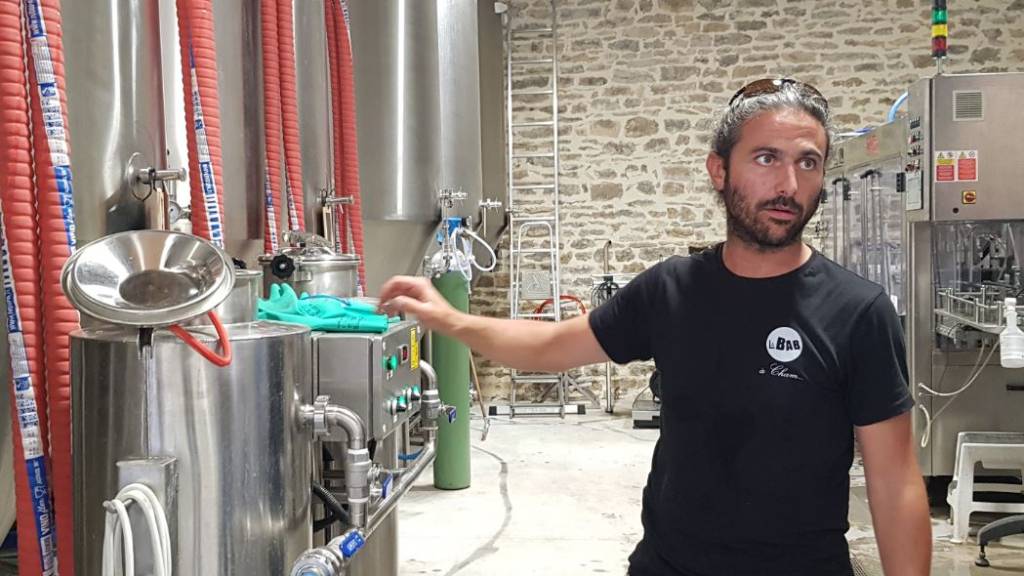
NOS/Frank Renout
ONS News•
-
Frank Renout
France correspondent
-
Frank Renout
France correspondent
French winegrowers are desperately looking for solutions as climate change regularly puts their crops at risk. Last year there was a heavy frost in late spring. Entire vines frozen: the harvest was largely lost. This summer, there is an unprecedented heat wave. The grapes sometimes dry out before they are ripe.
“Last year, 60% of our harvest was lost due to frost. My brother and I then decided: we are going to do things differently,” explains winemaker Arnaud Desfontaine, who runs Château de Chamilly in Burgundy with his brother Xavier.

NOS/Frank Renout
“We started making beer. We turned one of our wine cellars into a brewery. We buy barley and hops and make our own beer from them. Now we have a stable income. With wine, everything depends on the climate. you have little wine and you earn little. With beer, you have much more control: you determine much more yourself how much you earn.
The Desfontaine brothers have been winegrowers and brewers since last year. “We produce on average around 150,000 bottles of wine in a good year, and now also around 150,000 bottles of beer per year. This gives us economic security.”

NOS/Frank Renout
Château de Chamilly is not the only wine estate to set the tone. Throughout France, winegrowers are adapting their activities due to climate change. Not all French grape varieties are resistant to extreme weather. And the wine itself changes in taste due to rising temperatures. The mission is therefore: how and where to continue to make good French wine?
Normandy, relatively cold, is already nicknamed the new Eldorado for winegrowers. Since this year, the local authorities have been supporting new arrivals who wish to plant vines.
Famous French champagne houses such as Vranken-Pommery and Taittinger have even been making ‘bubble wine’ in England for a few years now. Of course, it can’t be called Champagne, because this brand name is protected.
“Around Bordeaux, experiments are underway with new grape varieties, such as the Touriga Nacional from Portugal,” says Kees van Leeuwen, a prominent Dutch researcher at the Agricultural University of Bordeaux. These new grapes are more resistant to heat. “It’s really a huge change for France. The strict rules all need to be adjusted. And the consumer who has always bought Chardonnay sometimes finds it difficult to accept that a Chardonnay varietal in a warmer climate is no longer the best option.
They also notice it in Burgundy. There they are experimenting with an old Chardonnay grape, which has not been used for years. “This grape actually grew too late in the season and was too acidic. But that’s a good thing, with the rising temperatures,” says Matthieu Mangenot of the Federation of Burgundy Winegrowers, the BIVB.

NOS/Frank Renout
If the grape grows later, it is less vulnerable to frost in the spring. And the acidity of this “old” grape actually compensates for today’s high temperatures: more sun leads to more sugar in the grapes, which leads to a (too) high alcohol percentage.
The French have been criticized for being slow in their adjustments. In 2012, a major scientific research project on wine and climate started, with recommendations on, for example, soil and water use, grape varieties and viticultural innovations. It is not until 2021 that the final results and a “national strategy” present to the government.
“French winegrowers are really working on it,” says scientist Kees van Leeuwen. “Because of course they want to continue producing good wine in a warmer and drier climate.”
The branch association in Burgundy also disputes that there is laxity. “Because of all the strict rules around French wine and around AOCs, appellations, changes can be a bit slow, yes,” explains Matthieu Mangenot. “However, we see through all the initiatives that there is an awareness: the winegrowers understand that something has to change.”

“Infuriatingly humble social media ninja. Devoted travel junkie. Student. Avid internet lover.”
 DodoFinance Breaking News Made For You!
DodoFinance Breaking News Made For You!